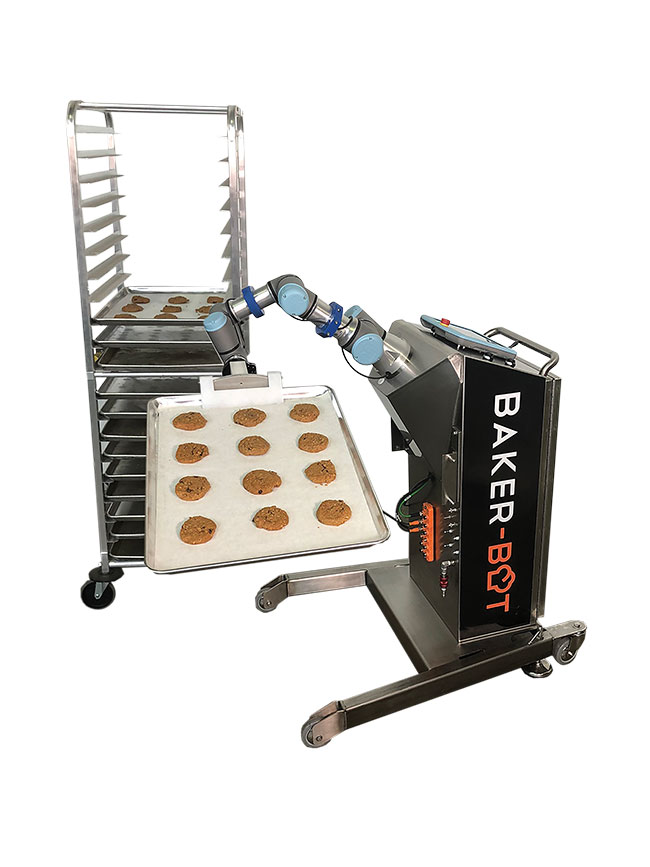
The Baker-bot Revolution
October 16, 2020
By
Bakers Journal
How Apex Motion Control’s Cobots help the baking industry
 From fine motor skills needed in decorating, to heavier tasks like loading and moving, Cobots can help save time and money.
From fine motor skills needed in decorating, to heavier tasks like loading and moving, Cobots can help save time and money. Martin Riis, the Director of sales marketing at Apex Motion Control knows about repetitive joint strain and back injuries. “My family was in the baking industry. I come from a family with chronic back injuries. So it’s near to my heart, trying to prevent some of these injuries. Every bakery I go into, it’s an aging labour force. They’re up in their fifties or sixties; I see some people in their seventies still working in these bakeries and doing all these very hard, manual tasks, where they would be way better utilized in other areas.”
Apex Motion Control offers relief to small and mid-sized bakeries with their “Cobots” – their collaborative robots that do the mindless tasks or de-panning, piping, stacking and other repetitive motion chores. The company has been involved with designing and selling robotic arms and devices for over twenty years.
For those who had never worked alongside industrial robots before, Riis reassures readers that they are safe, and have proximity sensors to stop them from either crashing into a human, or pressing too hard on a cake as it is decorating.
“Typically in small to medium-sized entreprise plants, they have a high-mix, low volume manufacturing, so they have a lot of SKUs, and rapid changeover going from one product to another product. Humans are really good at doing that on these production lines, because we just adapt so easily. Where the traditional industrial robots, a took up a lot of floor space and they just adapt as well and as quickly.
Riis adds that the Cobots present an advantage to a small bakery that observes social distancing, while still meeting production demands. “Where a human stands on a production line — say, packaging cookies into a clamshell — a Cobot can be rolled in to do that task and stand shoulder to shoulder with the other people still on that production line. Typically, what you want to do is give these Cobots tasks that are very repetitive and that strain the human body.”
Aside from preventing repetitive strain, reducing staffing costs and helping prevent the spread of COVID-19, the Cobots also help with more precise, detail-oriented tasks. People working on a factory production line can get distracted or lose focus during monotonous jobs. “Humans can get bored when standing on one of those bakery lines for eight hours. Sometimes we may have flipped the package, or done something incorrectly. The Cobots’ll do the same thing over and over and over again without any faltering. From a quality assurance viewpoint, that’s where they really shine.”
The issue of precision and hand-made detail is often a sore point with automation. While some consumers may express ambivalence about “machine-made” uniformity, some bakeries might find a way to personalize the designs the Cobots can deliver. A signature emblem or the name of the bakery can be programmed in to the Cobot to create a more one-of-a-kind icing signature.
Another advantage can be time saved in training and reduction in absenteeism. The Cobots can work longer hours, and once programmed are not likely to forget their objective. Another advantage is workplace safety: The Cobots have sensors that help them dodge out of the way of an oncoming obstacle, and prevents itself from dropping its task.
“They’re very customized solutions. So it’s primarily been the large bakeries, that has been able to invest in robotics, because bakeries had to have sort of the same production run over and over and over again, to really get the benefits and see the ROI on it,” explained Riis. “Now, Cobots, on the other hand, are small, agile and movable in some fashion. We’ve made it movable by mounting the actual arm on what we call the Bakerbot in the framework that we’ve developed – but Cobots, basically, are a class of robots that does need data that does not need physical guarding around them, meaning that a human can work, beside a Cobot safely.”
The robotic arm has what’s called force-limiting sensors in it, meaning that every joint on the robotic arm can sense if someone is touching it. “Cobots basically have technology that allows them to know if they’re meeting higher pressure, or a threshold, when they’re moving from A to B: If they do [sense an obstacle] they will stop. So, if a human or a person comes in contact with them, or touches the object that they’re moving, the Cobot will stop,” adds Riis.
In short, between offering a solution for keeping factory bakery workers safe from COVID-19 as well as reducing the potential for injury, the Cobots present a cost-effective solution to staffing needs for many small bakeries.
Print this page
Leave a Reply